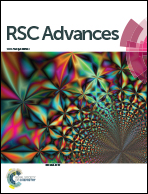Effect of coating composition on the anticorrosion performance of a silane sol–gel layer on mild steel
Abstract
In this study, the effect of coating composition on the protective performance of an eco-friendly silane sol–gel film consisting of tetraethoxysilane (TEOS), methyltriethoxysilane (MTES) and glycidyloxypropyltrimethoxysilane (GPS) applied on a mild steel substrate was investigated using electrochemical impedance spectroscopy and surface analysis methods. Through taking advantage of coating resistance, charge transfer resistance and low frequency impedance parameters, the optimum formulation of silane molecules offering the most effective corrosion resistance to the mild steel in 0.1 M NaCl solution was determined. The reaction between glycidyl groups of GPS molecules with silanol groups as shown by FTIR spectra may result in a strong reticulated network. However, water contact angles revealed an increase in hydrophilicity of the hybrid coating containing a high concentration of GPS, probably due to the higher amount of –CH–OH, produced in the reaction between glycidyl and silanol groups. As a result, it is found that there might be an optimum point in which a more reticulated structure overcomes the silane layer hydrophilicity.


 Please wait while we load your content...
Please wait while we load your content...